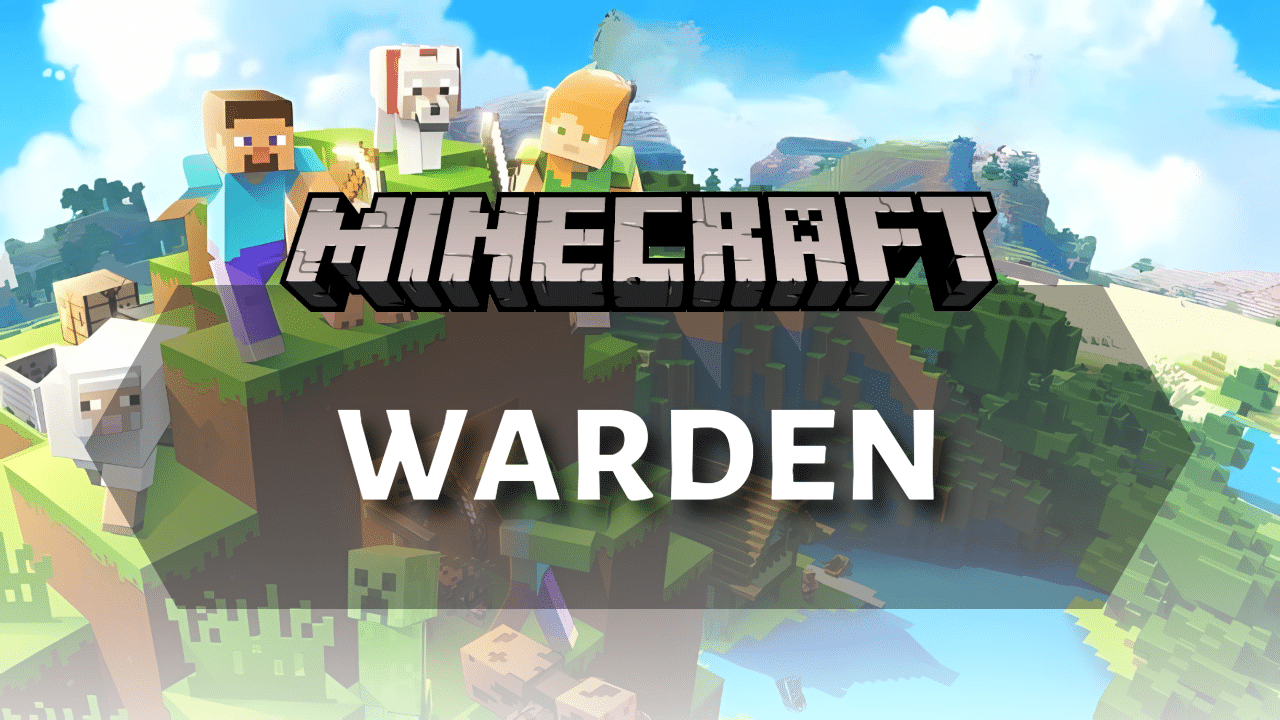
Introduction
The Warden is a powerful, hostile mob introduced in the 1.19 update (The Wild Update). It is found deep underground in the Deep Dark biome and within Ancient Cities. The Warden is intended to be a threat that players should avoid rather than fight. This formidable mob is blind and relies on its senses of hearing and smell to detect players and other mobs.
This Minecraft Bedrock Warden Guide breaks down everything you need to know: from the Warden’s spawning and behavior, to practical (and often risky) methods for containment and defeat, plus insights into its development history. Whether you’re here for technical mastery, gameplay optimization, or pure curiosity, you’ll find what you need to understand and possibly farm one of Minecraft’s most formidable foes.
Where and How to Find the Warden in Bedrock Edition
Wardens only spawn in the Deep Dark biome which is typically found deep underground around Y-level -50 and below, often under mountainous biomes like Frozen Peaks, Jagged Peaks, Stony Peaks, and Snowy Slopes. This biome is characterized by the presence of sculk blocks, including sculk sensors and sculk shriekers. Ancient Cities are structures that generate within the Deep Dark biome and are a primary location where Wardens are encountered.
Wardens do not spawn naturally like most other mobs. Instead, they are summoned by sculk shriekers. A sculk sensor detects vibrations caused by player actions or other mobs within an 8-block radius. When a sculk sensor detects a vibration, it can alert a sculk shrieker that is within 8 blocks. The sculk shrieker will then emit a loud scream, increasing the Warden warning level. Once a sculk shrieker is activated four times, a Warden will emerge from the ground nearby, provided there isn’t another Warden within a 24 to 48 block radius. Only naturally generated shriekers in the Deep Dark and Ancient Cities can summon Wardens; shriekers placed by players or generated by sculk catalysts cannot.
Warden
AttributeValueHealth500 (250 hearts) – One of the most durable non-boss mobsMelee DamageEasy: 16 (8 hearts)Normal: 30 (15 hearts)
Hard: 45 (22.5 hearts)Sonic Boom DamageEasy: 6 (3 hearts)
Normal: 10 (5 hearts)
Hard: 15 (7.5 hearts)Experience Drop5 XP (if killed by player or tamed wolf)Item Drop1 sculk catalyst (Looting has no effect)Size2.9 blocks tall, 0.9 blocks wide (can fit in 3-block-high corridors)
Warden Behavior in Bedrock Edition
The Warden is blind and cannot see players. It relies on vibrations and smell to locate targets. It can hear sounds up to 15 to 20 blocks away. Actions like running, sprinting, jumping, hitting or placing blocks, and triggering sculk shriekers will alert the Warden to your position. The Warden also has a sense of smell and will periodically sniff the air to locate players and mobs, even without any noise. It prioritizes smelling the most suspicious entity. When the Warden detects a target, it will roar and attempt to chase them.
The Warden inflicts the Darkness effect on all players within a 20-block radius every 6 seconds, severely limiting visibility. This effect is accompanied by a heartbeat sound emanating from the Warden’s chest, which speeds up as the Warden becomes more agitated. The Warden can fit through spaces 1 block wide and 3 blocks tall. It is immune to damage from fire and lava and does not take knockback. It can pursue targets through blocks like rails, cacti, and magma blocks.
The Warden is biased towards player vibrations, attacks, and contact, meaning it will likely attack a player first even if it is angrier at another mob. If the Warden does not detect any vibrations or smell any mobs for 60 seconds, it will burrow back into the ground and despawn, unless it has been named. If a Warden is floating on a liquid when calm, it will immediately despawn without burrowing. During the burrowing animation, the Warden cannot detect vibrations and can only be damaged by the /kill command.
Warden Attacks in Bedrock Edition
The Warden has two types of attacks: melee and ranged (sonic boom). Its melee attack is incredibly powerful, dealing significant damage: Easy: 8 hearts per hit; Normal: 15 hearts per hit; Hard: 22.5 hearts per hit. This makes it one of the heaviest-hitting mobs in Minecraft. A melee attack can disable a shield for five seconds.
If the Warden cannot reach its target with a melee attack, or if the target is far away (over 20 blocks), it will use a sonic boom attack. The sonic boom has a range of 20 blocks. To avoid it, you need to be at least 21 blocks away. This attack can pass through walls and pillars, so hiding behind them is ineffective. The damage of the sonic boom also depends on the difficulty: Easy: 3 hearts per hit; Normal: 5 hearts per hit; Hard: 7.5 hearts per hit. The sonic boom attack can bypass shields and armor. The Warden has a melee attack cooldown of nine seconds.
Tips to Avoid the Warden in Bedrock Edition
The primary strategy when encountering a Warden should be avoidance. Sneak (crouch) to move silently, as this reduces vibrations. Walk on wool blocks or carpets, as they muffle footsteps and prevent the Warden from hearing you. Ancient Cities often contain wool and carpet for this reason. Use night vision potions to navigate the darkness effect imposed by the Warden. Torches and fire are not very effective in the Deep Dark.
Distract the Warden by throwing snowballs or arrows in a direction away from you. The Warden will investigate the source of the vibration. Be careful not to throw too many projectiles at once, as the Warden might realize you are the source. Have an escape route planned. Since the Warden is slower than the player, gaining distance can be effective.
Using ender pearls to teleport a significant distance away immediately after a Warden spawns can be a safe escape method. Be mindful of the Ancient City’s roof to avoid fall damage. Shriekers will have a 10-second cooldown after one is activated, so teleporting into more sculk should not immediately trigger another Warden. If you are cornered, trying to pillar up can be risky, as the Warden’s sonic boom can still hit you. You need to build very high (over 20 blocks) to get out of the darkness and sonic boom range. If you can remain undetected for 60 seconds, the Warden will despawn.
Can You Kill the Warden in Bedrock Edition?
While technically possible, killing the Warden is extremely difficult and generally not recommended. The Warden has a massive 500 health points (250 hearts). This is more health than the Ender Dragon. Its powerful attacks can quickly defeat even players wearing full Netherite armor with Protection enchantments.
If you choose to fight, ranged attacks from a safe distance (over 20 blocks) are the only viable option. Using a bow with strong enchantments like Power V, Flame, and Punch can speed up the process. However, even with enchantments, it will take a significant number of arrows to defeat it. Trapping the Warden in a two-block deep pit using spruce trapdoors can prevent it from reaching you with melee attacks, allowing you to attack from a distance.
However, be aware of its sonic boom. Building a very tall tower (over 20 blocks high) and attacking from there is possible but risky, as the Warden is 3 blocks tall. The Resistance status effect is the only effect that reduces the Warden’s damage. This can be obtained from enchanted golden apples, potions of the turtle master, and beacons. Lava does not harm the Warden. Iron Golems will attack the Warden, but the Warden will easily defeat them. The best “strategy” to defeat the Warden might be to simply let it despawn after 60 seconds of no detected vibrations.
What the Warden Drops in Bedrock Edition
Upon death, the Warden drops a single sculk catalyst and 5 experience points. The drops are not affected by the Looting enchantment. Given the difficulty of defeating the Warden and the relatively meager rewards, it is generally not worth the risk to try and kill it. Mojang’s intention was for players to avoid the Warden.
Warden Farming
Why Bother Farming Wardens?
As mentioned, the main reason to farm Wardens is to obtain sculk catalysts. While sculk catalysts themselves cannot produce more of themselves, they are essential for the continuous generation of other sculk-related blocks. This can be useful for creating decorative builds, setting up specific environments for farms that don’t yield experience, or for technical players interested in utilizing sculk mechanics. Upon death, a Warden drops a single sculk catalyst and 5 experience points if killed by a player or a tamed wolf. The Looting enchantment does not affect the number of sculk catalysts dropped.
Spawning Requirements for Warden Farms
It is crucial to understand that only naturally generated sculk shriekers found in the Deep Dark biome and Ancient Cities can summon Wardens. Sculk shriekers placed by players or generated by sculk catalysts cannot summon Wardens.
To summon a Warden using a natural shrieker, a player must trigger it four times. Sculk sensors detect vibrations caused by player actions or other mobs and can alert shriekers within an 8-block radius. Each time a shrieker is activated by a player’s actions, it emits a loud scream, increasing the Warden warning level.
Once the warning level reaches four, a Warden will emerge from the ground nearby, provided there isn’t another Warden within a 24 to 48 block radius. The warning count is specific to each player.
The Warden needs a 1x3x1 block space to emerge. Up to 20 attempts are made to spawn the Warden within an 11x13x11 cubic area centered on the shrieker. Wardens will not spawn if the light level is 11 or higher, if another Warden is within a 48-block radius, or on slabs and stairs.
The Warden warning level decreases by one for every ten minutes of no shrieker activation by the player. If you go 40 minutes without triggering any shriekers, the counter will reset to zero.
Methods of Killing Wardens in a Farm
The sources suggest a few potential methods for killing Wardens in a farming context, although most emphasize avoidance due to the Warden’s strength.
Entity Cramming: This occurs when more than 24 entities are in a single block, causing damage to them.
Water: While Wardens are immune to lava and fire damage, water could hypothetically be used to kill Wardens, though it would take a very long time due to their high health. Wardens can move through water but cannot actively swim down.
Dropped Pointed Dripstone and Fall Damage: Wardens could die to dropped pointed dripstone or fall damage, although fall damage is less effective due to their high health.
Trapping: Some players might consider trapping the Warden in a 2×2 hole or a two-block deep trench using spruce trapdoors. This can immobilize the Warden and prevent its melee attacks. However, the Warden can still use its sonic boom attack within a 20-block range.
Loot Collection and AFK Chambers
To collect the dropped sculk catalysts, placing hoppers or hopper minecarts feeding into chests is effective.
For an automated farm, the only two ways to automatically summon Wardens are to stand on top of the sculk shrieker the farm is based around or throw a trident on top of the shrieker. The Warden can detect and attack through walls, so walling off an AFK chamber is unnecessary.
Important Considerations for Bedrock Edition
While the core mechanics of Warden spawning and behavior are similar across Java and Bedrock Editions, it’s important to note that some game rules, like doWardenSpawning, might have differences in availability or functionality between the two editions.
Ultimately, farming the Warden is a challenging endeavor due to its high health and powerful attacks. The relatively small reward of a single sculk catalyst might not be worth the effort and risk for all players. However, for those specifically needing a renewable source of sculk catalysts, understanding the spawning requirements and potential (albeit slow or complex) killing methods is crucial.
Change History
2020
Early Concepts
Initial mob name: Stalker
First prototype created with a bulky design.
Second stalker design: could shrink when chasing and disguise as treasure—scrapped for being too goofy.
Renamed to Hollowed—concepts created, prototype programmed but scrapped for being too gory.
October 3: Officially announced as the Warden during Minecraft Live 2020.
October 6: Teaser images showed its scale and hinted at behavior.
2021
October 16: Updated textures and spawning mechanics shown at Minecraft Live 2021.
November 26: Revealed that the Warden can smell and prioritizes the most suspicious target.
December 9: Development updates released for Bedrock Edition.
December 17–18: Emerging and burrowing animations showcased.
Deep Dark Experimental Snapshot 1 (Java): Warden first added for testing.
2022 – Java Edition Snapshots
22w12a
Warden added officially (not undead).
New melee animation.
Vertical reach increased from 3 to 4 blocks.
Immune to fire and lava.
22w13a
Can pass over rails.
22w14a
Slows in water again.
Affected by bubble columns.
Gets angry when bumped by any living mob.
22w15a
Gains ranged sonic boom attack.
Can smell players from farther away.
Vertical anger range increased to 20 blocks.
Vertical melee reach reverted.
22w16a
Vertical melee reach reduced to 2 blocks.
doWardenSpawning gamerule added.
22w17a
Drops 1 sculk catalyst on death.
Ranged attack: lower damage, shorter cooldown.
Ranged attack bypasses shields and armor.
22w18a
Sonic boom particle textures updated.
22w19a
Ranged damage now scales with difficulty.
Requires four sculk shrieker activations to spawn.
Pre-release 3
Sonic boom attack ignores Protection enchantment.
2022 – Bedrock Edition Betas
Beta 1.18.30.32
Warden added under Wild Update toggle.
Missing hit and death sounds; outdated behavior.
Beta 1.19.0.20
Available without experimental toggle.
Sound effects for hurt, death, and anger added.
Anger toward despawned mobs is preserved.
No longer gets angry at inanimate objects or other Wardens.
Beta 1.19.0.26
Gains ranged attack.
Enhanced smell range and anger radius.
Gets angry at any mob it bumps into.
Prioritizes attacking players.
Beta 1.19.0.28
Drops sculk catalyst.
Ranged attack damage reduced; cooldown shortened.
Attack bypasses armor and shields.
Conclusion
The Warden is not just another mob—it’s a statement. Its design pushes players to think differently about survival, exploration, and risk versus reward. With its overwhelming strength and keen senses, the Warden discourages direct combat and encourages stealth, creativity, and preparation. Farming it is no small task, and the sculk catalyst it drops may seem modest in comparison to the effort required, but for technical players and resource optimizers, that one item can unlock a range of sculk-based mechanics and aesthetic possibilities.
Understanding the Warden—its behavior, limitations, and history—empowers players to engage with Minecraft’s most dangerous biome in meaningful ways. Whether you’re building a farm, crafting lore-rich adventures, or pushing the boundaries of what’s possible in the Deep Dark, the Warden offers a rare challenge that rewards patience, ingenuity, and a bit of courage.
So plan carefully, tread quietly, and if you choose to farm the Warden—do so with respect for the monster Mojang never intended you to defeat.
If you’re looking for more guides, be sure to explore the website for more tips and tricks. Enjoy your adventure, and happy mining!













